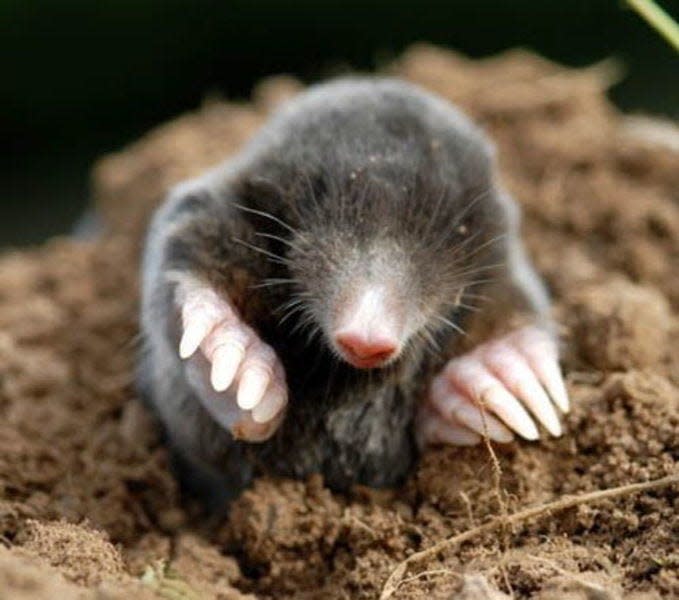Mighty and mysterious moles
One mammal of North Texas and Southwestern Oklahoma is superbly adapted for its underground life and is almost never seen above ground; but its shallow, subsurface tunnels (or runs) and surface mounds (or hills) are evidence of its presence. In fact, the Eastern Mole and its relatives are probably best known from the idiom and metaphorical saying of “making mountains out of mole hills.” The conical, volcano-shaped mole hills are formed as moles excavate tunnels and push soil toward the surface. These earthworks sometimes cause problems in our fields, yards, and gardens if they collapse after rains or when equipment and/or livestock are driven or tread over the hills and runways. Collapses and collisions of mole hills and runways can create erosional conditions, equipment damage, and/or injury to livestock.

The Eastern Mole’s body is approximately 4 – 6.5 inches long with a short, sparsely haired, round tail. It’s fur is of uniform length, dense, and dark brown to silvery-colored with lighter hairs on the belly and neck. The nose is elongated into a nearly naked, sensitive snout and the mole’s small, rudimentary eyes are covered over by skin and hair and are probably only capable of detecting light. Moles have excellent hearing but lack external ears. Their tiny ear openings are concealed and protected by dense fur. The forefeet, front legs, and shoulders of the Eastern Mole are specialized for digging. The hands are enlarged, rather spade-shaped, and the palms are wider than long. Also, the forearms and palms are rotated so that the palms face laterally outward. Moles have large, pointed first incisors, a single pair of small, sharp, upper canines, and W-shaped molars and premolars with sharp cusps. The streamlined body shape of the Eastern Mole is well suited to a digging lifestyle.
Even the fur of moles is uniquely adapted to allow ease of travel within tunnel systems in both forward and backward directions. The hairs are hinged and can bend in any direction with almost no resistance. This characteristic imparts a velvet-like feel and appearance to mole fur. The pelts of the European Mole, a relative of the Eastern Mole, were once in demand for fashionable top hats, wraps, coats, waistcoats, and vests because of the fur’s durability, warmth, and waterproof properties.
The Eastern mole spends 99 percent of its life underground and has a rather Goldilocks preference for soils which are moist, loamy and/or sandy but which are neither too wet or dry, nor too rocky or clayey. Similar to other fossorial (burrowing) animals, the preferred habitats of the Eastern Mole are more dependent upon soil types and conditions than many other environmental factors. Moles excavate extensive burrow and tunnel systems containing foraging runways and nesting, latrine, and food storage chambers. Some foraging runways are only used a single time; whereas, other runways may be used for many years. Runways are often very shallow (just below the ground’s surface) during ideal seasons of spring and summer; but, as the ground temperatures fall and/or the soils become drier, preferred prey items dig deeper into the soil and Eastern Moles follow their food by excavating deeper tunnel systems.
The Eastern Mole is an insectivore and its preferred prey items include earthworms, insects, and insect larvae. Moles have voracious appetites and can daily consume quantities of prey equalling 30 – 70 percent of their body weights. Moles locate prey using their keen senses of hearing, smell, and touch as they excavate and maintain lengthy and often interconnected foraging runways (sometimes exceeding 1,000 ft. in length). Moles dig with their forepaws and use a twisting, swimming-like motion while pushing soil to the sides and behind themselves. Their twisting, upward thrusting body movements result in slightly domed surface runways. Most activity and foraging is conducted during daylight hours when insect and earthworm prey are more active; but moles also forage during nighttime hours and throughout the year.
Except for a brief annual reproductive season, the Eastern Mole is a solitary species. Males usually begin searching for mates during late winter and/or early spring months. A single litter of two to five young are born in a nest chamber and share the burrow system of their mother until old enough to forage on their own and, thereafter, establish separate burrow systems. Young moles attain maturity within approximately one year.
Because their burrowing activities can cause damage to croplands, yards, gardens, and pasture lands several types of traps have been developed to capture moles as the animals travel along their surface runways. Stepping on and collapsing a runway in a small area and/or opening the runway by removing its surface soil will help determine if the resident mole is currently using the tunnel. Moles quickly sense when a runway has been collapsed and/or opened and they travel to the site to repair the damage! In lieu of trapping, several types of commercial mole repellents are available. Also, castor oil, peppermint oil, and Marigolds are recommended as natural mole repellents.
Although moles disturb vegetation and create runways and mole hills, the Eastern Mole’s fossorial activities also aerate and loosen soils and, as a consequence, improve water retention and peculation through a soil’s horizons. The Eastern Mole also acts as a biological control agent because of its voracious appetite and diet comprised largely of soil invertebrates, larvae, and insects. Moles consume large numbers of June Bug and Cutworm Moth larvae and other insects known to damage crops, gardens, and lawns.
Eastern Moles rarely appear above ground but, if their hills and runs are in an area, you can be assured that these superb tunnelers and insect eaters are on the job. Although moles may construct a mole hill on your property, they, in turn, will consume a mountain’s worth of potentially harmful insects and insect larvae!
This article originally appeared on Wichita Falls Times Record News: Mighty and mysterious moles

